
• A storm front carrying heavy rains pushed through parts of the lower Southeast during the last week of October, carrying the possible benefits of wetting soils enough to finish digging peanuts and provide moisture for planting fall grains.• Widespread showers in late October helped to stabilize conditions in North Carolina and South Carolina, so there wasn’t much change in the drought designations in those states.
November 4, 2010

A storm front carrying heavy rains pushed through parts of the lower Southeast during the last week of October, carrying the possible benefits of wetting soils enough to finish digging peanuts and provide moisture for planting fall grains.
However, the showers did little to alleviate the effects of a period of drought and extreme heat that has plagued the region since July, leading to lower-than-expected yields and quality in cotton, peanuts and soybeans.
Nearing the end of October, heavy showers and thunderstorms were seen from southern Arkansas and northern Louisiana into Tennessee and southern Kentucky. Rain was heaviest — in some cases more than 4 inches — in a narrow east-west band in northern Alabama, which led to a modest reduction of the moderate drought designation there, according to the U.S. Drought Monitor dated Oct. 26.
Elsewhere in the region, reports from the field indicate the rain offered little significant drought relief, but perhaps stabilized stream flows and soil moisture in the short-term. Consequently, reductions in drought intensity and coverage were minor, and generally confined to areas where rain exceeded 2 inches.
The U.S. Drought Monitor states that outside the area that received significant rainfall, drought indices continued to depict a worsening picture, with Standardized Precipitation Indices and seven-day stream flows indicating severe drought or greater over southern portions of Mississippi and Louisiana. Consequently, extreme drought conditions were expanded into west-central Mississippi.
Widespread showers in late October helped to stabilize conditions in North Carolina and South Carolina, so there wasn’t much change in the drought designations in those states. Nevertheless, seven-day average stream flows below the 10th percentile over much of central South Carolina and south-central North Carolina were indicative of the need for additional rainfall to prevent further drought expansion in this region. Farther south, severe drought conditions were expanded northward along the Georgia coast in response to a lack of rainfall over the past 90 days.
Mostly dry, warmer-than-normal weather led to an increase in drought across eastern portions of the Easter Gulf Coast region. In eastern Florida, seven-day average stream flows continued to decline steadily. Along central portions of Florida’s eastern coast, precipitation has totaled less than 50 percent of normal over the past 180 days, with deficits during that timeframe in excess of 16 inches.
In southern Florida, abnormal dryness and moderate drought were expanded to account for the declining stream flows and increasing precipitation deficits. From northern Florida into Alabama, the drought designation was expanded or increased for a second consecutive week to reflect declining soil moisture, low stream flows, and below-normal rainfall. In these northern extreme drought areas, precipitation over the past 90 days has averaged 20 to 40 percent of normal, with deficits locally in excess of 8 inches.
Growers across the Florida Panhandle and northern Peninsula were in desperate need of rain to help aid crop development and the digging of peanuts. Peanut harvesting in the final week of October was 84 percent complete compared to 77 percent from the previous week. Last year, 59 percent of peanuts were harvested by this same date while the five-year average was 74 percent.
Irrigating to dig peanuts
In Washington County, Fla., peanut grades were well below average in comparison to previous years. Some growers in Columbia County irrigated their peanut fields in order to dig due to the ground being too dry. Cotton picking remained active across the Panhandle.
Dry weather allowed most field activities to progress in Florida. In Escambia and Santa Rosa counties, growers have delayed planting fall vegetables because the ground was too dry.
Cooler evening temperatures delayed the crop maturity by about two weeks for cucumbers in central and southern Peninsula areas, while producers in the Hastings area continued to plant cabbage.
Light harvesting of bell peppers, eggplant and snap beans was under way. Tomato harvesting in the central Peninsula areas was expected to begin shortly. Producers marketed avocados, cucumbers, okra, squash and tomatoes.
In Alabama, extreme drought was identified in Geneva and parts of Houston counties as conditions worsened for the state. It was reported that soils in the area were too hard to prepare for planting fall crops.
In Alabama’s St. Clair County, it was reported that wheat for winter grazing was not seeded because there was not any topsoil moisture to germinate the seed. In other areas of the state, winter wheat already had been seeded but had not germinated due to a lack of moisture.
In Lauderdale County, the dry weather has been good for fall harvest but reported yields on harvested soybeans were disappointing.
In many areas of Alabama, pastures and livestock were in dire need of rainfall.
In Georgia meanwhile, a few scattered showers did little to help relieve drought conditions. Soil moisture conditions were rated at 35 percent very short, 48 percent short, 16 percent adequate, and 1 percent surplus.
Over three-quarters of the Georgia soybean crop had dropped leaves in late October and harvest was at about 20 percent. Nearly half of the sorghum had been harvested for grain, and almost half of the cotton had been harvested. Winter wheat planting was moving ahead slowly. More than three-quarters of peanuts had been dug and two-thirds had been harvested by late October.
About the Author(s)
You May Also Like



